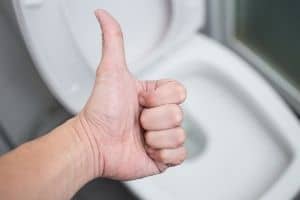Have you ever watched the sunset or taken a long drive to soak in beautiful views? If you appreciate natural splendor, or if you just like to breathe clean air, you should consider implementing some simple conservation strategies into your daily life.
Conservation can sound like a big, ominous task, but it doesn’t have to be. You can cut your energy costs by turning your computer off at night, turning off lights when you leave a room, and using energy-efficient light bulbs. Recycling plastics and glass is environment-friendly, and you can sign up for electronic billing to reduce paper waste.
If you want to conserve water, you can take shorter showers, wash full loads of laundry rather than small loads, and you can save water with every single toilet flush by upgrading your bathroom plumbing to low-flush toilets. In this article, we’ll tell you all about high-efficiency toilets and how they save water and the planet.
The History of Low-Flush Toilets

If you’re not familiar with water conservation, you’re probably wondering, what are low-flushing toilets? As the name implies, low-flush toilets use less water in each flush than older toilet models.
Believe it or not, toilets use more water in the typical home than showers or laundry, or any other water appliances. In the United States, low-flush toilets hit the market in the 1990s as a response to the government’s policies to reduce water use across the country.
However, the first high-efficiency toilets were anything but efficient. The main design modification was a smaller water tank, which resulted in homeowners flushing multiple times to wash away waste. Instead of saving water, they were often using more than they had been with their old toilets.
How do Low-Flush Toilets Use Less Water?

Modern low-flush toilets work much better than the first models. How do they work? Toilets have historically used gravity, pressure, or both to carry away waste. Low-flush toilets also use gravity and pressure, combined with some other smart design modifications.
When you press the flush lever on your toilet, it lifts the flapper inside the tank and lets water flow down into your bowl and pipes. Today’s high-efficiency toilets utilize the pressure created from gravity because they have smaller pipes, and they’re often glazed to reduce friction.
Some models rely on pressure more than gravity. Inside the tank, these models have a vessel with pressurized air. When you flush, the air pocket pushes water through the bowl. As the tank refills with water, the air vessel refills as well for the next flush.
Save Money AND the Planet!

Old toilets can use between 5 and 7 gallons of water in each flush, but high-efficiency appliances use only 1.6 gallons of water each time. When you reduce your water use so drastically, you’ll see a big difference in your monthly bill.
Dual-flush toilets have two settings, one for solid waste and one for liquid waste. The flush for liquid waste uses just 1.3 gallons of water. If you’re serious about water conservation, a dual-flush toilet is the most efficient option currently available.
TIP From Shamrock Plumbing & Drain Cleaning Inc: Check to see if your city or nearby municipal water organization offers a rebate for purchasing low-flush toilets for your home. Over time, high-efficiency toilets will pay for themselves, but getting a rebate upfront is a great way to make upgrading easier.
There are so many things that you can do to help the environment. The best way for us to make a difference is to work together in our own homes and communities. Share your conservation strategies with your friends and neighbors and encourage them to join you in protecting our planet.
You can start by picking up the litter you find in your neighborhood, collecting rainwater to feed your garden, and upgrading to high-efficiency toilets. What will you do today to help the planet?

